 Drug development is a very expensive operation. For a pharmaceutical company, bringing a new drug to market can cost around $1 billion — a worthwhile investment if that medication is then sold to millions of consumers. But what if the market for that drug is much smaller — say, 290 people per year?
Drug development is a very expensive operation. For a pharmaceutical company, bringing a new drug to market can cost around $1 billion — a worthwhile investment if that medication is then sold to millions of consumers. But what if the market for that drug is much smaller — say, 290 people per year?
That’s the number of patients who chose to obtain a prescription for medical aid in dying last year in the state of Oregon, where the practice has been legal since 1997. While nationwide data is still limited, most states that participate in MAID — California, Colorado, Hawaii, Maine, Montana, New Jersey, Oregon, Washington, and Vermont, as well as the District of Columbia — report well under a thousand prescriptions written each year. Only about two-thirds of the patients who receive these prescriptions end up filling them.
Perhaps because of this — and because MAID is still somewhat controversial — pharmaceutical companies have yet to invest in large-scale testing or production of medications for medical aid in dying.

Drug manufacturers invest millions in developing new drugs, but not if they don’t expect to profit from them.
Yet in spite of scant resources, dedicated researchers have been working for many years to develop safe, effective medication for medical aid in dying. “We were looking for drugs that would give a calm, peaceful death and not cause a lot of side effects for the family to witness or the patient to experience,” said Dr. Carol Parrot, a retired anesthesiologist who volunteers with MAID patients through End of Life Washington.
Until recently, the most common medications for medical aid in dying were pentobarbital and secobarbital, but both have become increasingly difficult to obtain. Pentobarbital has been used by some states to deliver capital punishment, and the drug’s manufacturers have restricted its distribution in an effort to combat this. Meanwhile, the price of secobarbital (under the brand name Seconal) has increased exponentially in recent years.
Instead, medication for medical aid in dying now typically consists of a combination of morphine, diazepam, amitriptyline and digoxin. The first two drugs put the patient into a deep sleep and inhibit their respiratory function, while the latter two impede cardiac function.
Many factors, such as the patient’s weight, drug tolerance, and stomach conditions, can affect how long the dying process takes. Most patients fall asleep in 5-10 minutes, and death usually occurs within two hours, although it can sometimes take much longer.
A longer process is not cause for alarm and will not make a difference to the patient, who is sleeping deeply at that point. Still, it can be difficult for the patient’s loved ones, who have prepared themselves to say goodbye and may have to wait several hours for closure.
The current MAID options are also not ideal for patients with certain physical conditions, such as severe gastrointestinal issues or a high tolerance to sedatives and/or opiates. In such cases, doctors may need to modify the prescription or discuss other options with the patient and their family.
While MAID proponents hope to overcome these obstacles in the future, that will depend on the resources available for research and testing — which, in turn, may depend on whether acceptance of MAID continues to grow across the nation.

 Research Lags on Medical Aid in Dying Drugs
Research Lags on Medical Aid in Dying Drugs


 How Dare You Die Now!
How Dare You Die Now!
 Debating Medical Aid in Dying
Debating Medical Aid in Dying
 “Help Me, Helen”
“Help Me, Helen”














